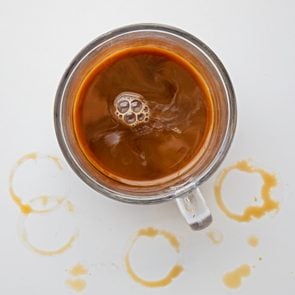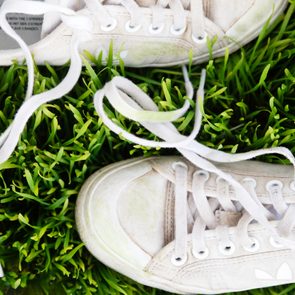How to Get Stinky Smells Out of Your Clothes, According to Cleaning Experts
Updated: Apr. 19, 2024
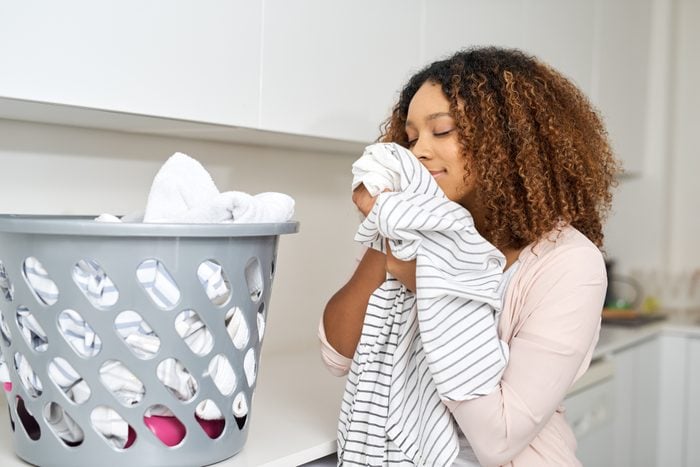
Need to remove mildew, sweat, smoke or other offensive odors from your clothing? Here's exactly how to get smells out of your clothes—quickly and easily.
Smelly clothes are a friend to no one, but on the flip side, they are a sign of a life well-lived. Whether it’s perfume from date night, bonfire smoke or sweat from a night of dancing, scent leaves a trail that can be a doozy to remove. Even if you follow care instructions to a T, some stinks just refuse to go away and might require a bit more effort. Luckily, we’ve got step-by-step instructions from experts who know a thing or two about how to get smells out of clothes.
“Odors that linger on clothing can be frustrating, especially after you’ve washed an item and the smell remains,” says Mary Gagliardi, aka Dr. Laundry, a stain scientist at Clorox and expert on how to remove stains and smells. “Dealing effectively with odors on clothing—meaning the odors are removed, not just covered up—often requires more attention than just throwing it in the wash.”
Reader’s Digest talked to Gagliardi and Alicia Sokolowski of AspenClean eco-friendly laundry and cleaning products to bring you these proven tips for fresh, clean, stink-free clothing. With the right products and techniques, your clothes will smell as easy-breezy as the process to get them there. Here’s what you need to know.
Get Reader’s Digest’s Read Up newsletter for more cleaning, humor, travel, tech and fun facts all week long.
About the experts
Reviewed for accuracy by: Mary Marlowe Leverette, a highly regarded fabric-care, stain-removal and housekeeping expert with more than 40 years of experience. |
How to get smells out of clothes
The No. 1 laundry rule is that some detergents, water temperatures and drying options don’t play nicely together, so take the extra two minutes to read the care label before settling on an odor-killing strategy. “It’s always important to check the care label before laundering an item, whether you’ve got an odor problem or not,” says Gagliardi. “Knowing fiber content is important for helping you choose the right laundry products, especially if your laundry problem requires more aggressive laundering.”
Once you’re armed with that information, remember that different clothes and fabrics require different approaches to odor removal. For example, never use bleach on spandex, even if it’s a plain white T-shirt. Ditto for wool, silk, mohair and leather. Cotton and polyester are more forgiving. That’s one reason Sokolowski always reaches for natural products, such as vinegar and baking soda. They’re safe, versatile and inexpensive—and they work. (But of course, test first, especially on sensitive or exotic fabrics.) Below, the experts walk us through how to clean even the stinkiest clothes.
How to get mildew and musty smells out of clothes
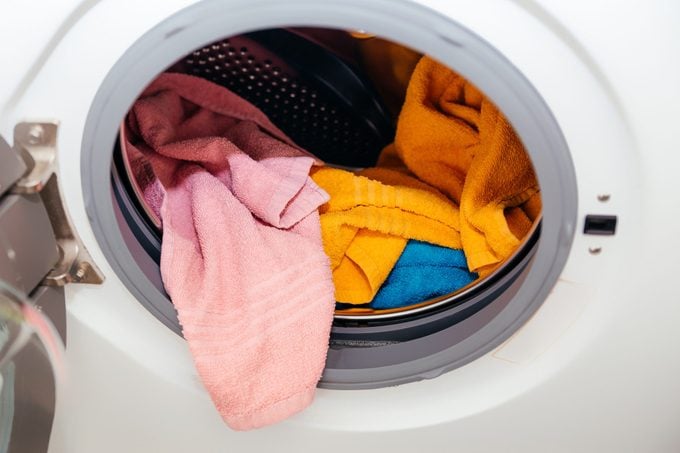
“Mildew is a type of fungus, which is different than bacteria or viruses,” explains Gagliardi. While viruses and bacteria are neutralized by the sanitizing agents in detergents, fungus generally requires something stronger. Gagliardi says products formulated with sodium hypochlorite (bleach) are the most effective mildew-busters. But be aware that they’re not appropriate for every fabric type. Always check the label before using bleach to kill mildew on your clothes.
You’ll also want to check your washer. Does it smell musty? “The inner workings of a clothes washer harbor soil buildup, especially in HE washers,” Gagliardi says. That’s because water is never completely pumped from the machine, so a little bit of dirt and residue can stay behind, providing a moist environment for fungus to thrive. Before tackling the clothing, run a cycle in your washer with bleach, without clothes. Add bleach to the fill line on the washing machine dispenser, then run a hot cycle with an extra rinse. Repeat if necessary. Then follow these steps to remove mildew smells from your clothes.
Supplies you’ll need
- Bleach
- Water
- Outdoor clothesline or drying rack
Directions
- Do a colorfastness test. Add 2 teaspoons of bleach to 1/4 cup of water. Apply one drop to a hidden spot. Wait one minute, then rinse and blot dry. No color change means you can safely bleach the item.
- Wash your bleach-safe clothes using regular detergent and 1/3 cup of bleach. Wash non-bleach-safe clothes using regular detergent and a color-safe bleach. If the clothing cannot withstand chlorine bleach, laundry expert Mary Marlowe Leverette suggests using pine oil or a phenolic disinfectant (Lysol). Follow usage instructions for laundry on the product label.
- Machine wash on the hottest temperature setting to sanitize thoroughly.
- This process should remove the mildew smell from clothes, but if the clothing still doesn’t smell quite right, repeat the process.
- Let the item air-dry in the sun, if your climate allows, which will also help reduce mildew odors.
How to get sweat smells out of clothes
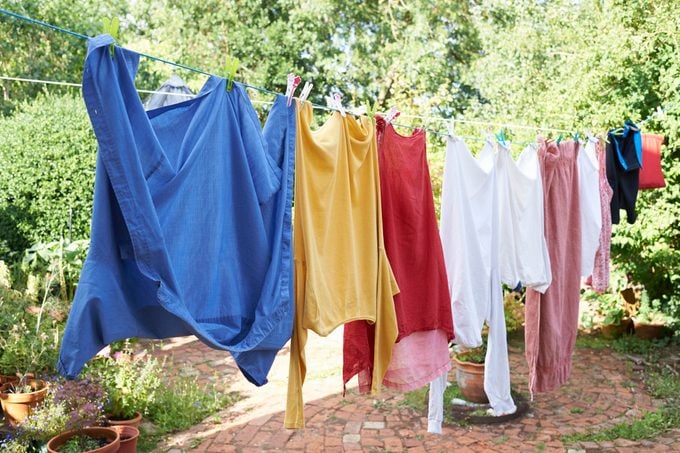
Some might argue (“some” meaning us) that getting rid of sweat stains and smells is just as hard as the workout itself, but don’t throw in the towel just yet. Sweat doesn’t really have a smell—it’s mostly water and minerals—but when sweat reacts with bacteria on your skin, that’s when you get that funky body odor. Skin cells, detergent residue and the cozy confines of your armpits add to the problem.
For workout clothes and other sweaty items, Sokolowski likes to start with fresh air, followed by an enzyme-based detergent. Enzymes are proteins that “break down organic compounds, including sweat and bacteria,” Sokolowski says, adding that enzyme-based detergent formulations are “usually pretty powerful.” Enzymatic laundry detergents often have multiple enzymes designed to target specific odor-causing stains.
Supplies you’ll need
- Outdoor clothesline or drying rack
- Enzyme-based detergent
Directions
- Hang your sweat-smelling clothing outside for a couple of hours, if possible. Sunshine is a natural disinfectant.
- Pre-treat sweat stains and stinky spots with an enzyme detergent or stain stick.
- Check the labels of your clothing and set the washer to the recommended temperature and cycle.
- Add 2 tablespoons or less of enzyme detergent to washer, based on load size. Resist adding extra. Too much detergent makes your clothes dirty, not clean.
- Hang outside to dry, or tumble dry as indicated on the label.
How to get smoke smells out of clothes
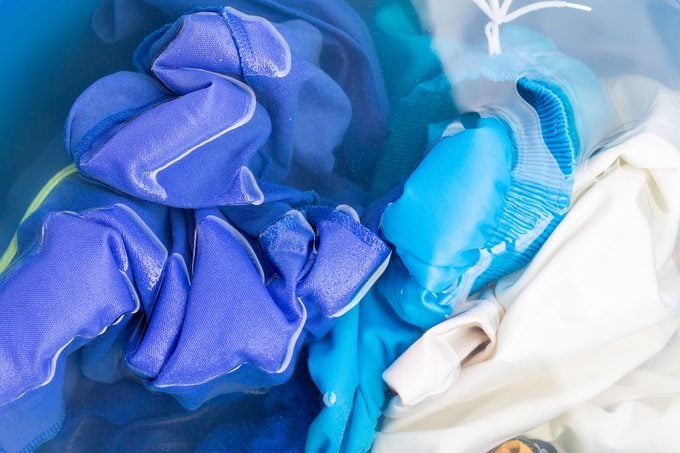
Residual smoke odor, whether it’s from a bonfire or a cigarette, is heavy and “sticks” to fabrics. Before you turn to detergents, Sokolowski is firm: “Fresh air and sunlight is the first thing we would do.” Hang your smoky clothes outside to let the breeze carry away (at least some of) those heavy, smelly smoke molecules. Then, turn to what Sokolowski calls one of the “most perfect cleaning agents”: white vinegar.
Supplies you’ll need
- Vinegar
- Water
- Large bucket
- Detergent
Directions
- Hang or lay your clothes outside in the sunshine and fresh air.
- Leave the clothes out for a few hours, turning them occasionally.
- Make a 50-50 solution of vinegar and water in a large bowl, bucket or tub.
- Soak clothes for a few hours or overnight.
- Wash your clothes as you normally would. Check the labels for the correct temp and cycle.
How to get perfume smells out of clothes
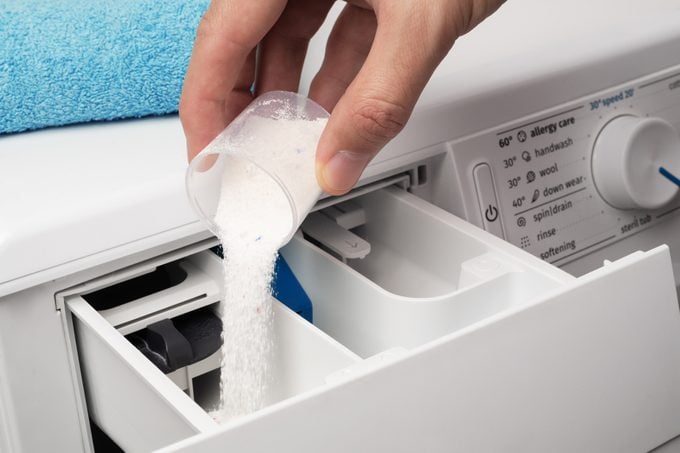
According to Gagliardi, when more than a mist of perfume gets on fabric, the ethanol within the formulation evaporates quickly, leaving you with an oily, smelly stain. “That’s why it’s a harder stain to get out,” she says. “But it’s not impossible—just treat it like any other oil stain.” Cut through that stinky mess with a dish soap pre-treatment, then boost the laundry with a tablespoon of bleach.
Before starting, Gagliardi says to do a colorfastness test. Add 2 teaspoons of liquid chlorine bleach to 1/4 cup of water. Apply a tiny drop to an inconspicuous spot and wait one minute. Rinse and blot dry. No color change means you can safely bleach the item.
Supplies you’ll need
- Dish soap
- Water
- Bleach
Directions
- Pre-treat the stain when the fabric is dry (don’t rinse the item with water first). To do so, dip a cloth in liquid dish detergent and gently dab and rub it into the stain.
- Wait five minutes. Rinse the stain with warm water to remove the dish detergent.
- Add 1 tablespoon of bleach into the bleach dispenser (for white, bleach-safe clothing only). Alternatively, add a tablespoon of color-safe bleach for bleach-safe colored clothes, or white clothes made of spandex. For non-bleach-safe clothing, simply repeat steps 1 to 2 until the oil stain is removed.
- Wash the item in the hottest water recommended for the specific fabric.
How to get gasoline smells out of clothes
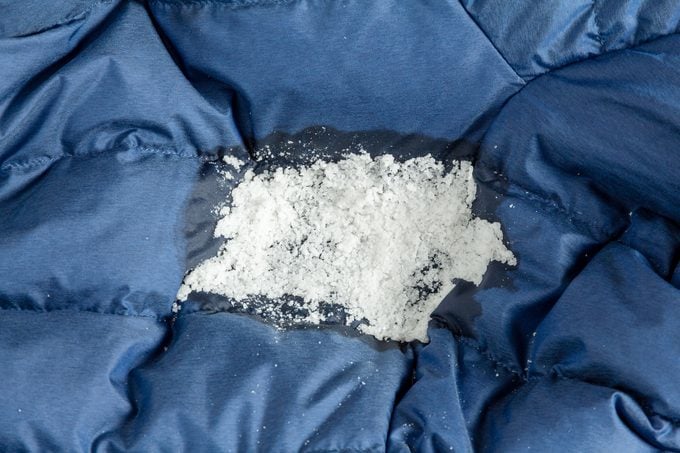
Be careful when dealing with gasoline stains or smells. Gasoline is highly flammable, and any clothing contaminated with gas needs to be handled with extra care. If you have spilled gasoline on your clothing, it’s important not to just toss it in your washer and (especially) dryer. Heat and friction can ignite gasoline, but following a few precautionary steps will help.
Supplies you’ll need
- Dish soap
- Cornstarch (optional)
Directions
- Air out clothing stained with (or smelling like) gasoline outdoors for 24 hours.
- Optional step: Sprinkle cornstarch on the gasoline-smelly clothes, Sokolowski suggests. Allow it to sit for a few hours to absorb the odor before brushing it off. Then proceed with the below.
- Spot clean by gently rubbing liquid dish soap into any visible gasoline stains.
- Let sit for five minutes.
- Rinse the stain with warm water, then air-dry.
- Repeat steps 1 to 4 if you still smell gas.
- Launder as usual and air-dry.
Tips for removing odors from clothes
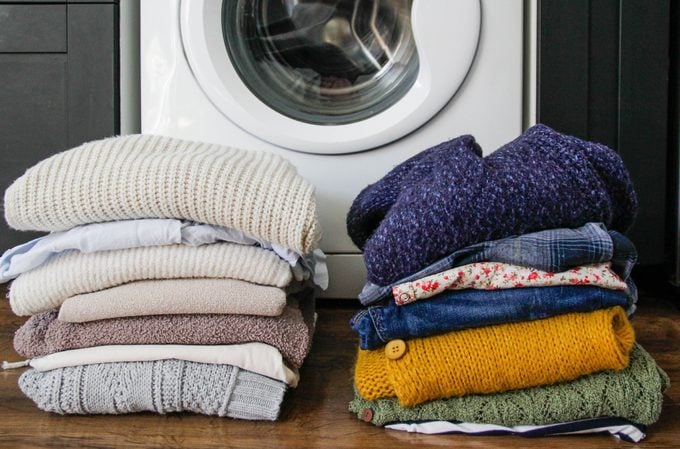
Perfume, sweat and smoke are pretty common clothing odors, but even if you have a funky smell that’s not on this list, the pros have you covered. Here are some general tips for odor removal that can work on many fabrics. It’s always a good idea to test an inconspicuous area first.
Try liquor
Vodka is shockingly effective at odor removal. Pour some into a spray bottle, then spritz it on unfresh clothes. As the alcohol evaporates, it will lift odors away. Keep in mind that laundry likes its vodka strong. Adding water will weaken the high alcohol content, which is where the spirit gets its odor-eliminating power. In fact, find the cheapest bottle of vodka you can find and watch in wonder as the stink disappears.
Add vinegar
Vinegar is a staple product in many cleaning schedules, so it should be no surprise that it has laundry benefits. In fact, adding a cup of vinegar to your wash cycle has stood the test of time. It can be used on both whites and colors, and your clothes will not only look brighter, they’ll smell way fresher too. Sokolowski loves vinegar for laundry, cleaning and, yes, odor removal. Soak smelly clothes in vinegar and water, then wash as usual. “Although, you might get the smell of white vinegar instead,” Sokolowski says, “so you can always add a few drops of organic essential oils.”
Sprinkle some baking soda
Sweaty, smoky or just plain dirty clothes? “Baking soda is great at absorbing odors,” Sokolowski says. Place smelly clothes in a large plastic bag or tub with a lid, and place an open box of baking soda inside. Close the container and let it sit overnight. You can also sprinkle the baking soda directly on the clothes, then if needed, “shake the clothes well to remove the baking soda before washing,” Sokolowski says.
Another hall-of-fame laundry hack is adding 1/2 cup of baking soda to your suds. It softens hard water and makes your detergent work better. (Washing soda, a similar but stronger compound, works even better.) But a word to the wise: Don’t use baking soda and vinegar together—they’re an either/or situation, as they will cancel out each other and you’ll still be left with stinky clothes.
Don’t add more detergent
Although it sounds like a good idea, it’s not. Too much detergent will leave a slimy residue, which traps odors and makes them even harder to remove. Less is more when it comes to laundry detergent. If you’ve been using more detergent than needed, or lots of products like fabric softeners and dryer sheets, you may notice your towels aren’t as absorbent as they used to be, and they may feel rough against your skin—especially if you have hard water.
Activate the charcoal
Sokolowski says for smoky, musty or otherwise offensive clothing odors, activated charcoal can help. This form of highly porous, processed elemental carbon removes odors through a process called adhesion. “Place activated charcoal in a shallow dish” and put it near your stinky clothes, Sokolowski says. Allow it to work for a day or two, then launder as usual.
Why trust us
At Reader’s Digest, we’re committed to producing high-quality content by writers with expertise and experience in their field in consultation with relevant, qualified experts. For this piece, we tapped our experience writing about cleaning, laundry and home maintenance, sourcing only experts in the field. Then Mary Marlowe Leverette, a fabric-care, stain-removal and laundry expert with more than 40 years of industry experience, gave it a rigorous review to ensure that all information is accurate and offers the best possible advice to readers. We verified all facts and data and backed them with credible sourcing, and we will revisit them over time to ensure they remain accurate and up to date. Read more about our team, our contributors and our editorial policies.
Sources:
- Mary Gagliardi, Clorox in-house scientist; email interview, Sept. 20, 2021
- Alicia Sokolowski, president and co-CEO of AspenClean; email interview, Jan. 4, 2024

